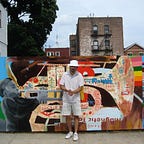The Cocainemaker, Reefer Madness, and the Vice-President of The Coca-Cola Company
Part One: How the Coca gets into Coke
In 1886, a pharmacist named Dr. John Pemberton mixed extract of the green coca leaf — containing the recently discovered marvel of cocaine — with the caffeine kick of West African kola nuts, making a “Brain Workers’ Panacea” tonic called Coca-Cola.
Touted to relieve mental and physical exhaustion, “Coke” arrived alongside a wave of cocaine products advertised to ease toothaches and labor pains. Cocaine was said to cure fatigue, nervousness, impotence, even addiction to morphine.
But the medical miracle soon changed into the story of a crime epidemic. Cocaine’s addictive properties were discovered and its increased availability fueled racial fears: cocaine made Negroes insane and murderous; Jewish doctors were identified as its peddlers.
The United States began prohibition of coca leaf, along with the cocaine it produces, with the Harrison Narcotics Act of 1914.
Just eleven years earlier, The Coca-Cola Company had begun working with a German cocainemaker, Dr. Louis Schaefer, importing Peruvian coca leaf to his chemical plant in Maywood, New Jersey.
Schaefer Alkaloid Works became Maywood Chemical Works and supplied ingredients to Coca-Cola, including caffeine from coffee beans and tea dust, and a mixture of kola and a non-narcotic coca “flavoring extract.” This secret formula was dubbed “Merchandise No. 5.”
This is Maywood today...
Maywood Chemical was acquired by the Stepan Chemical Company in 1959. Over the past century, as coca leaf became illegal around the world, sparking one of the longest, most expensive and violent wars in history, thousands of tons of coca shipped to this secure, discreet facility.
- click to see Stepan’s current D.E.A. registration to import coca leaves
- click to see current registration for the bulk manufacturing of cocaine
Much credit for this arrangement goes to Harry Anslinger and Ralph Hayes.
In 1930, Harry J. Anslinger became commissioner of the US Federal Bureau of Narcotics. He led the ban against coca leaf, while simultaneously helping secure The Coca-Cola Company’s special access to it, through the administrations of seven presidents, until his retirement from government in 1970.
Ralph Hayes, former aide to the US Secretary of War, was a Washington businessman known for preserving important associations with powerful people. Hayes was hired by Coca-Cola in 1932 and began a friendship with Harry Anslinger that grew over the next three decades.
Commissioner Anslinger was a notorious antidrug zealot, best known for his relentless crusade against the marijuana plant in the “Reefer Madness” era. But he was an integral supporter to the coca plant business of Coca-Cola and Maywood, forwarding them relevant State Department reports, prying media inquires, and intelligence on South American coca farmers along with maps of their cocaine factories.
As the law against coca evolved, Anslinger was consulted by and cooperated with Hayes and Maywood executives on legislative phraseology.
Coca-Cola’s privileged access to coca leaf was codified alongside the very laws that would prohibit its traditional users from growing it.
In turn, Ralph Hayes used his political influence, charm, and tactful contributions to support Anslinger’s long tenure in Washington, DC.
Their mutual interests culminated during the drafting of the 1961 United Nations Single Convention on Narcotic Drugs.
By then, nine separate legal agreements between nations had created an overly complex system of drug laws. Following thirteen years of negotiation, the Single Convention on Narcotic Drugs was adopted to simplify and supersede all previous protocols.
Today, the United Nations Single Convention on Narcotic Drugs is one of three treaties, along with the 1971 Convention on Psychotropic Substances and the 1988 Convention Against Illicit Traffic in Narcotic Drugs and Psychotropic Substances, that define the international drug control system.
Representing the United States, Harry Anslinger steered to outlaw the coca plant. The Single Convention, as adopted, orders people worldwide to stop chewing coca leaves, whether for health or culture, and mandates the uprooting and destruction of all wild bushes.
And it contains the provision that allows Coca-Cola to use coca.
This illustrated essay is an excerpt from the book, A Secret History of Coffee, Coca & Cola by Ricardo Cortés.
All images are by the author, drawn in pencil, pen, and color pencil. The letters of correspondence are based on the original documents from:
Subject files of the Bureau of Narcotics and Dangerous Drugs. Record Group 170: Boxes 20, 23, 63, 64, 141, 170. US National Archives, College Park, MD.
H.J. Anslinger Papers, 1835–1970. Accession 1959–0006H, Historical Collections and Labor Archives, Special Collections Library, University Libraries, Pennsylvania State University, University Park, PA.
Some letters have been edited for length, but great effort was made to ensure the writers’ intentions and meanings have not been interfered with, distorted, or misrepresented.
To see some of the original documents, take a look here.
To learn more, see Part Two: How Coca-Cola Changed the World for Coca and Part Three: I Wasn’t the First Person to Find the NJ Cocaine Factory.
And to find out why The Coca-Cola Company began to grow coca in the United States, buy the book.
